Empire Galactique (Galactic Empire) by Hulk Smash!
Introduction
Original SA post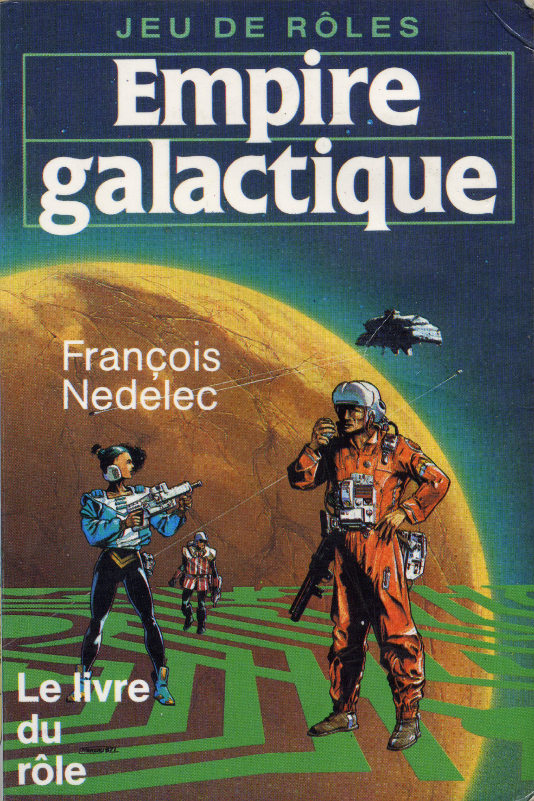
Time for some obscure French game up in this joint!
Empire Galactique or Galactic Empire is a granddaddy of French RPG. It was originally published in 1984 with a second edition in 1987. The second edition – the one reviewed here – came in pocket book format of all things. One book for the players and another for the GM with several pocket book sized supplements and adventures later on. The whole line is a mish-mash of styles, from space-opera, to Dune, Ringworld and the Foundation series. Almost all the illustrations in the book are done by one guy by the name of Manchu and are what initially drew me to it. I had no idea who Manchu was but I dug his style back then. Kind of a cross between John Byrne and a poor man’s Moebius.
I remember finding this in a used book store as a teenager. It was buried in the trashy sci-fi section of a bargain bin and I bought it for $1. The problem was that what I bought was the GM guide and, no matter how many times I went back to that store, I could never find the player’s guide (which has character creation rules), so I never played it. I have tracked down the books I was missing since then though. I still never played it and this is frankly the first time I'm actually reading through it in an effort to understand the rules.
Introduction
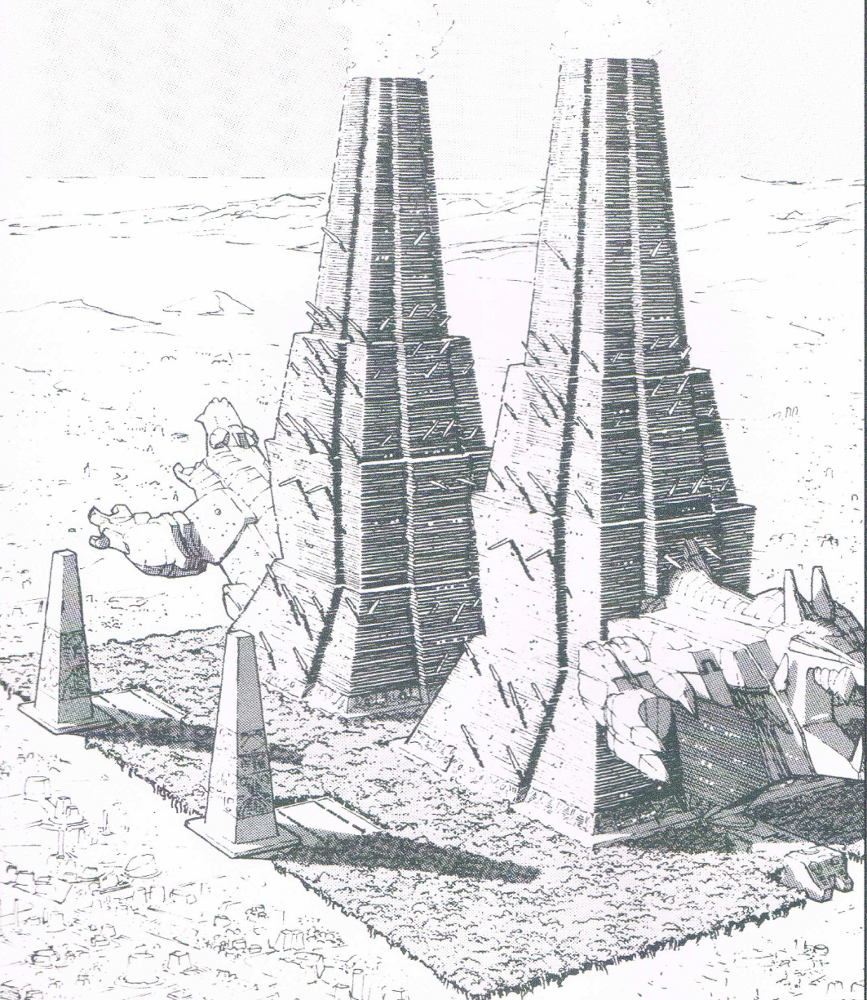
The book opens with a bit of in-character action. The Adventurer Jason McCord (there’s a lot of names that I’m sure sounded cool to the French author back then, like Lili Remora, Aloysius Van Eflin and Sugar) is in a bind, he’s making his way through an alien jungle with a band of like-minded individuals and things are not going as planned, having been misled by his employer. Jason then reflects that the person he should be mad at is himself, or rather the person playing him for agreeing to play in this RPG (what a twist!). This is how the book eases into the then standard “what the hell in a role-playing game anyway?”
The explanation is pretty standard and then it goes into what is needed to play the game:
- From 4 to 10 people
- At least 3 hours’ time
- Unplug the phone (because you don’t let real life distract you when playing for your life)
- Some drinks and snacks
- Maps, minis, space-music, general ambiance stuff
- A bunch of d6
- Character sheets
- It notes that some people show up in costume but that it’s not necessary. However the GM may want to wear a mask to present the proper impartial face
Off to a good start!
Next time : Character Creation
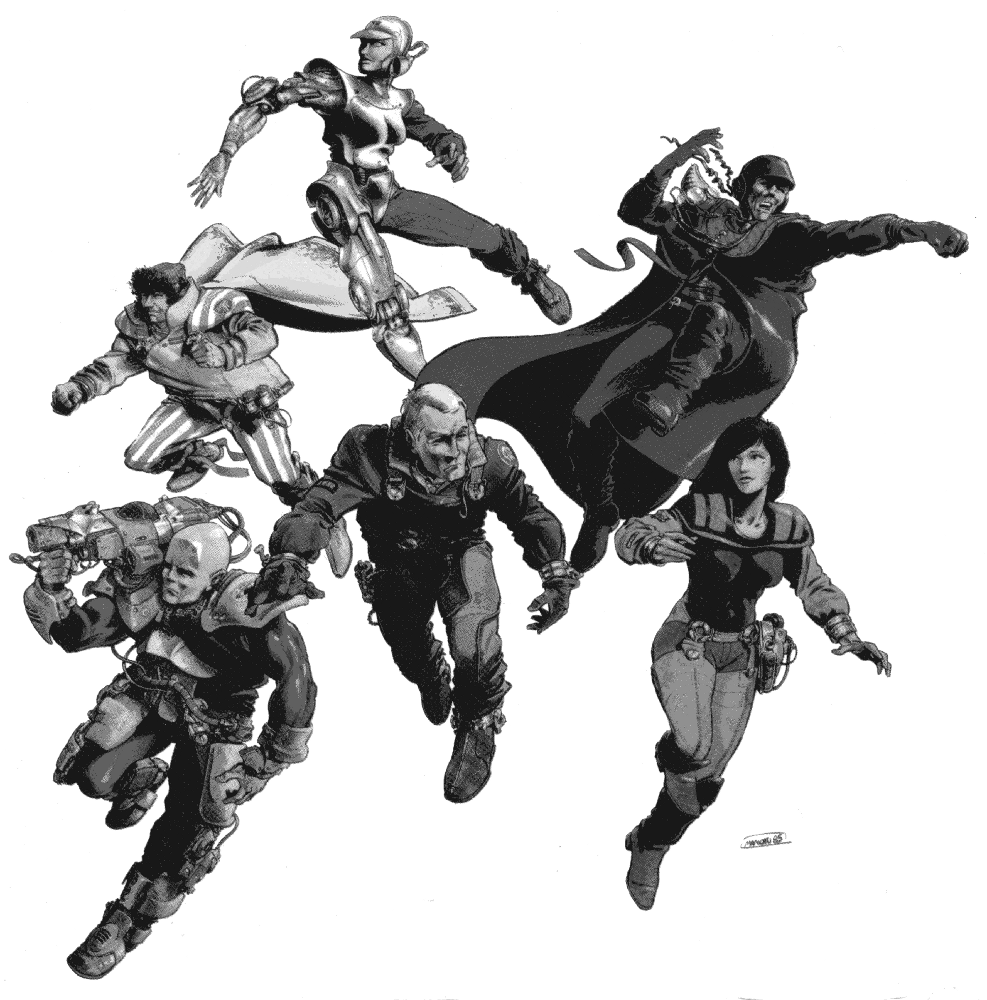
Pictured: The 6 character archetypes available.
Character Creation
Original SA postTasoth posted:
One of those archetypes looks like Soviet peasant superhero and the other looks like proto-Midnighter. I'm already digging it from the art alone.
Haha. Well, you're nowhere near the mark unfortunately


Character Creation
Galactic Empire has 6 stats. Each stat is represented as an icon that doesn’t do much besides add a visual component to it. The 6 main stats are:
 Charm
Charisma, magnetism, presence, etc.
Charm
Charisma, magnetism, presence, etc.
 Endurance
How tough you are.
Endurance
How tough you are.
 Intelligence
Smarts.
Intelligence
Smarts.
 Strength
Physical prowess.
Strength
Physical prowess.
 Will
Force of will, also used for PSI talents later.
Will
Force of will, also used for PSI talents later.
 Agility
Dexterity, agility, coordination, etc.
Agility
Dexterity, agility, coordination, etc.
To generate stats the player rolls 6d6 + 30 and distributes the points among the stats. No stat can be lower than 2 or higher than 12. 7 being average. Completely non politically correct, the game gives the example of a 2 intelligence as being like “a retarded person who can barely count on his fingers.”
quote:
Example: We roll 6d6 + 30 and get a total of 51 points to distribute. This would give us an average of around 8/9 per stat which isn’t bad at all.
The next step listed is to generate the 8 derived attributes. These are the average of 3 of the main stats. The derived attributes are:
 Beauty
Physical appearance
Beauty
Physical appearance
 Intuition
Knowing when something’s not quite right
Intuition
Knowing when something’s not quite right
 Mental Resistance
Mental health, resistance to stress, The total of the 3 stats (not the average) is HP for verbal conflict, sanity. If it reaches 0, you become an NPC
Mental Resistance
Mental health, resistance to stress, The total of the 3 stats (not the average) is HP for verbal conflict, sanity. If it reaches 0, you become an NPC
 Physical Resistance
Being able to handle pain, damage. The total of the 3 stats (not the average) is the HP of the PC.
Physical Resistance
Being able to handle pain, damage. The total of the 3 stats (not the average) is the HP of the PC.
 Reflexes
Reaction speed.
Reflexes
Reaction speed.
 Stealth
Moving silently or unseen.
Stealth
Moving silently or unseen.
 Adaptability
Being able to adapt, melt with the crowd, etc.
Adaptability
Being able to adapt, melt with the crowd, etc.
 Perception
The 5 senses. Roll to hear a whisper or see at night, etc.
Perception
The 5 senses. Roll to hear a whisper or see at night, etc.
quote:
An average dude with 7 in Endurance, Agility and Strength would have a 7 physical resistance stat and a total of 21 HP.
Choosing a career
Annoyingly, the book only now talks about the available career archetypes. The problem is that you need at least a 7 in the stat associated with the career to apply for it and you might have spread your stats differently had you known at the start. Not a huge deal but this is the first mention of that stat requirement.
As mentioned in the previous post, there are 6 available career archetypes. They are numbered 1-6 and that number becomes important down the line. Choosing a career is important as it will influence which skills you have access to later on. Each career has a set list of skills that they have access to and when you go to school for that career you get a chance to learn about a random skill available to it. More on that in a bit.
The 6 careers are:
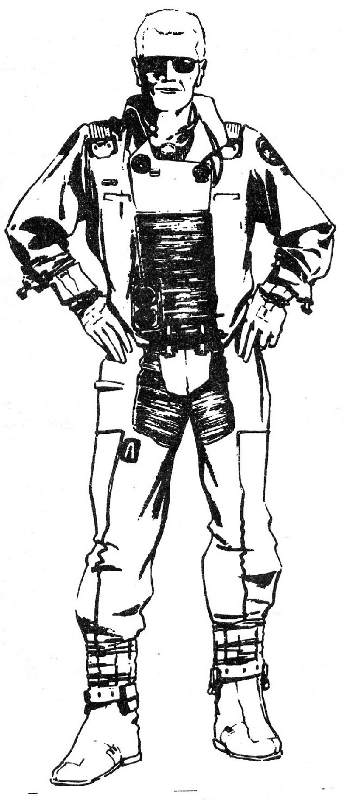
1. Adventurer
Adventurers are jack-of-all-trades. They are the only career that can learn a skill from any other career’s skill list. The downside is that they can die during the course of their career’s school year. Yep, you can die in character creation in this RPG.
The adventurer’s primary stat is Endurance
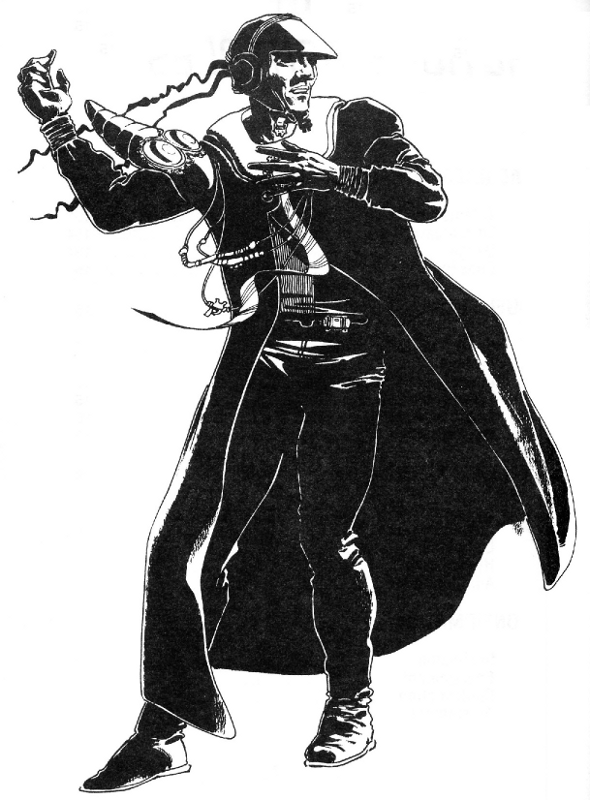
2. Priests
Priests are basically space-wizard. They are prohibited from using any weapon; they start weak but get stronger as they are the only class that can learn both the Telekinesis and Telepathy PSI powers.
The Priest’s primary stat is Will
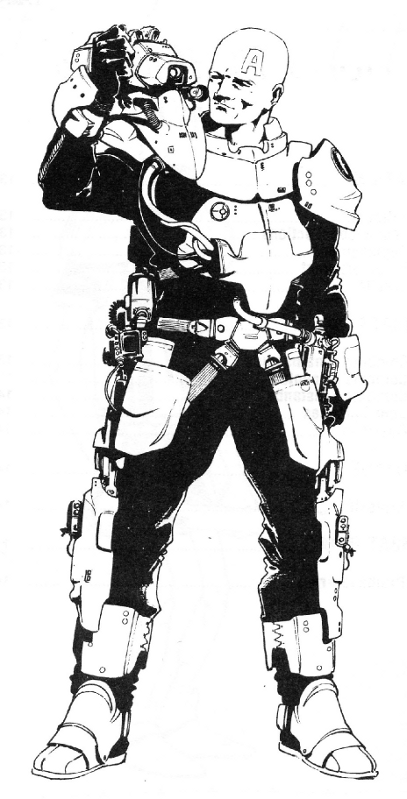
3. Soldier
Soldiers are, well, soldiers. They are the master of melee and range combat.
The Soldier’s primary stat is Strength
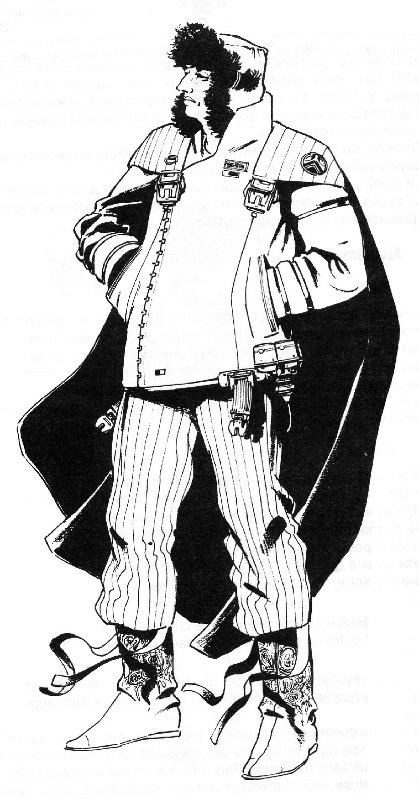
4. Merchant
Merchants are smooth talkers, con artists, smugglers and such. Wearing the latest fashions, they are the group’s mouthpiece and are always looking to make a deal.
The Merchant’s primary stat is Charm
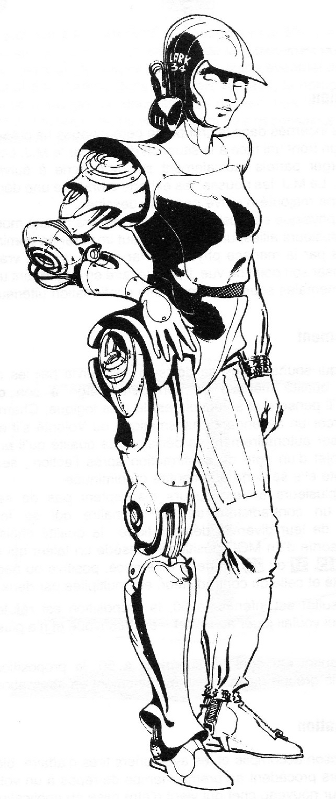
5. Navyborg
Navyborgs (cyborg navigators) are manipulators. They like to play behind the scenes, can remote control robotic devices and are more machine than man
 The Navybog guild controls interstellar navigation.
The Navybog guild controls interstellar navigation.
The Navyborg’s primary stat is Agility
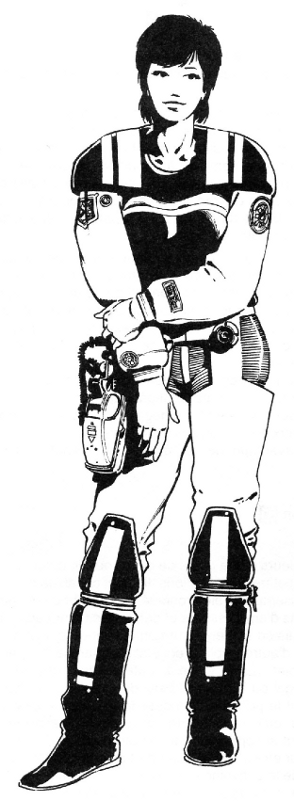
6. Tekno
Teknos are inventors, mechanics, mad scientists and Macgyver rolled into one. The book points out that the archetypical Tekno is this guy:
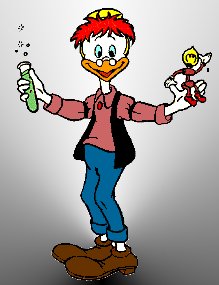
The Tekno’s primary stat is Intelligence
Career Schools
Career school is where you get your skills. Every career skill starts at 0. To go through a school year and find out which skill you may have a chance to improve, follow this process:
Entrance Exam
- Your age is 18 at the start
- Roll 2d6 and multiply the results by your career’s primary stat.
- If the result is above 2xAge, you are admitted to the school (this is the entrance exam)
- If the result is equal or lower, you are not admitted to this school and add 1 year to your age. You can reapply next year to this or a different school (using that new school’s primary stat if you do)
quote:
If you’re trying to get into Tekno school at 18, you’d roll 2d6 * INT and hope that the result is greater than 36. If not, you’d now be 19 and can try again or try for a different school like Navyborg where you’d then roll 2d6 * AGI instead but your target number would now be 38
Learning Skills
- Roll 1d6 (let’s say you roll a 3) and look up your career’s number (e.g. 4 for Merchant)
- You can now try to learn either skill numbered 34 or 43
- Roll 3d6 and add them. If the result is lower than your career’s main stat, you gain +1 to the chosen skill. If it’s above, you lost that year and learned nothing. If it’s equal , you gain +2 to the chosen skill
- Repeat for 3 more years (4 years of school total)
quote:
Each skill has a 2 digit number associated with it. For example, every skill that has the number 5 in it can be learned by Navyborg. The skill 55 (Robotic Combat) can only be learned by Navyborg (and Adventurer but we’ll get to that after).
So if our would be Tekno rolled a 3 he then would have a choice to try and learn either 36 Strategy (also available to career 3. Soldier) or 63 Mechanic (also available to a soldier)
Promotion Exam
Once you’ve done 4 consecutive years at a given school, there is a promotion exam. There are six ranks for each school (only the 1st 3 are available in this book). To go from rank 0 to 1 a PC must have at least 3 skills of the school above 0. To go from rank 1 to 2 they need 6 and from rank 2 to 3 they need 9.
If the player fails to meet the requirements for a promotion, they must try to re-enroll in the school using the entrance exam rules above – using their current age of course. Note that if a player chooses to they can apply to different schools over character creation and thus get a rank in multiple careers. Players are only allowed to start adventuring once they have successfully achieved at least rank 1 in one school.
There are no rules for when they must stop trying and actually get out of school beyond the fact that 1. They can’t reach higher than rank 3 in a school and 2. Starting at 50, there are aging rules which lower your stats.
quote:
Once our Tekno has at least 3 school skills at above 0, they are promoted to rank 1 – Apprentice. At 6 skills they would then be rank 2 – Repairman and rank 3 – Technician at 9 skills. The other 3 ranks are: 4 – Engineer, 5 – Designer and 6 – Architect. Soldiers get more conventional ranks like Lieutenant, Captain and Commander
What if I’m playing an Adventurer?
Adventurers are a bit of a special case. They learn the hard way, on the streets and spaceports. To find out which skills an Adventurer gets to try and learn, roll 2d6. The two numbers will then give which skills he got to choose from that year.
quote:
An Adventurer rolls a 2 and a 4. He would then get to choose from the normally Priest and Merchant reserved skills of 24 Disguise or 42 Alien Language (choice)
Adventurers don’t have ranks so instead, every 4 years, they roll 2d6 * Strength. If the result is higher than his current age, he’s good to go. If he rolls lower than his current age, he dies . This is the only class that can die during character creation.
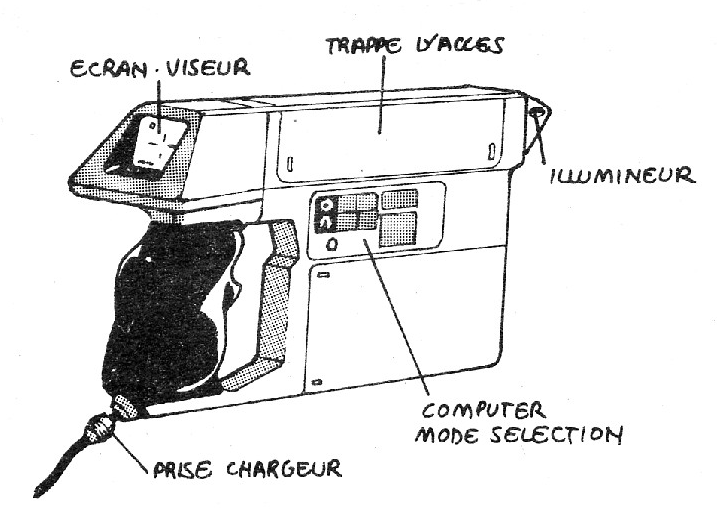
Shooty laser
Next time : Skills & Combat Resolution and Experience
Skill Test Resolution
Original SA post
Skill Test Resolution
This is a roll under system. Difficulty levels are (1 to 5)d6 rolled under Stat + Skill Level. Each skill has 3 possible stats tied to it. There’s a bit of an early narrative system where the player has to choose one of the three stats to use to accomplish an action.
quote:
For example: The skill Mechanic has Agility, Strength and Will listed as possible stats to use when making a check. When, say, fixing an engine you could say that you’ll use Strength to just hammer the thing into place, use Agility to fix the root cause of the issue by dismantling and rebuilding the engine or use Will to make proper repairs, knowing you will have to service the engine later.
To resolve an action in Galactic Empire, the player and the GM first have to figure out a few things.
1. The GM first has to define if the action is Easy, Normal or Hard .
2. The player has to decide which of the 3 stats for the skill he will use. This will define if the player:
- Wants vague or temporary results or is taking his time
- Wants normal results, takes the normal amount of time
- Wants detailed or permanent results or wants to take less than usual time to complete the action
You then cross reference the difficulty on the table below to find the number of d6 needed to roll under the stat + skill level target number.

Some resolutions are made by rolling under either a straight stat or derived stat. This is always the same by rolling 2d6 against the stat/derived stat. The GM can modify the stat by up to +10//-10 to reflect difficulty.
quote:
the PC is trying to sneak through a guarded area. The GM rules that it’s dark enough that there are no modifiers. The PC then would roll 2d6 and try to roll under his Stealth derived stat
Unskilled use
If the player does not have a skill, he can still attempt it but as if he had a skill value of -3. If he succeeds, the skill value is then -2. Another success to -1 and so on. Once it reaches an actual value of 0 the skill stops increasing this way and only goes up with normal experience rules (below).
Combat Resolution
initiative
Even though initiative has to be taken into account, there is no initiative roll. The game mentions that initiative is solely up to the GMs discretion.
The GM is to take into account things like: are the PCs surprised? Do they trust their would-be opponent? Who has the higher ground? Are the players into the story? Have the players been contrarian (according to the GM) during the game? Yes? Too bad, asshole, you just lost initiative.

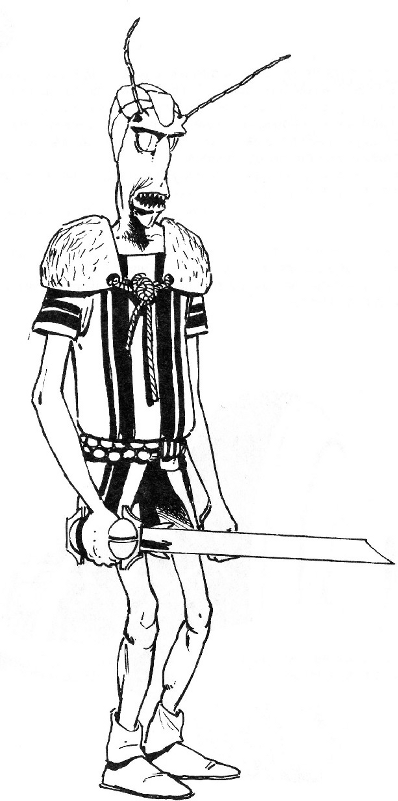
A fearsome alien with a space-sword
Melee Combat
1. The first step is for the player to decide if he is Attacking (Strength), Riposting (Agility) or Parrying (Endurance)
2. Then the player decides if he’s aiming low, high or middle
3. Next he decides if he wants to attack to be Vague, Normal or Precise.
This will give the number of d6 to roll under stat+skill using the same table as above (just replace easy with low, normal with middle and difficult with high).
Damage is then calculated by looking up a table. The gist of it is that the more dice you roll and the closer you get to your target number without going over, the more damage you do. Damage points are mitigated by armour (if any) and are subtracted from Physical Resistance.
quote:
If a PC is using a club and does a high and precise attack (5d6) and rolls a 13 against his target number of, say, 14, he would then do 7 points of damage.
When riposting both opponents would roll their respective d6 and both apply the results (e.g. both could connect and inflict damage, only one or both miss). Parrying is an opposed check; the attacker has to succeed by a wider margin than the defender otherwise the attack is parried.
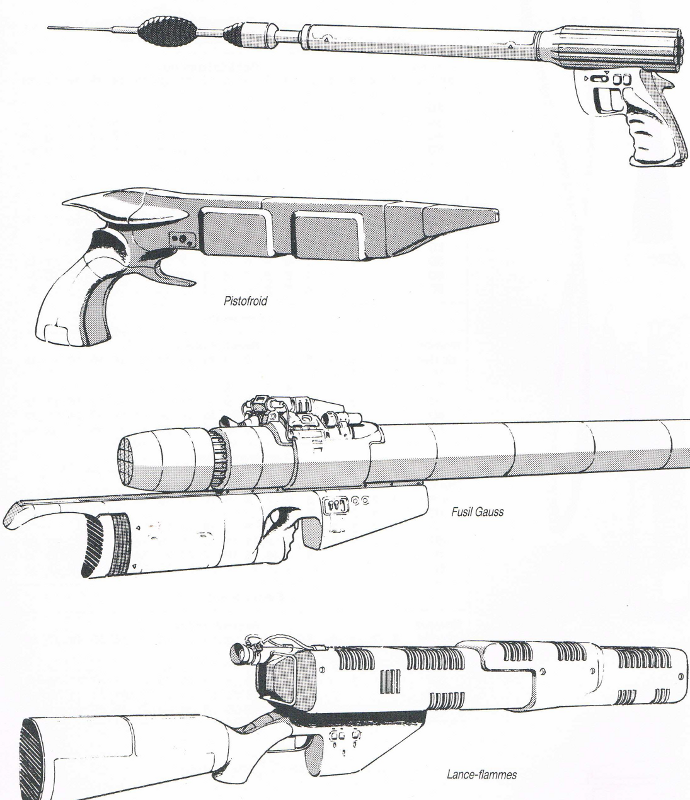
Pew-Pew guns.
Range Combat
This one is easy as it’s a straight up skill check against range combat skills. Damage is dependent on number of d6 rolled, same as melee combat.
Verbal Combat
The rules are the same as melee combat except that low, middle and high are replaced with friendly, neutral and hostile respectively. They represent the attitude of the target towards the verbal attacker. This system is used to resolve things like: bargaining for prices, lying convincingly, or dealing a sick burn.
The stat to use for verbal combat depends on the type of thing the PC is trying to accomplish. You would use Charm when seducing or cajoling a target, Will when challenging their faith in something and Intelligence when appealing to logic. Damage is resolved like any other combat but the “damage” points are taken away from Mental Resistance. When that reaches 0, the target is convinced of the argument, switches sides, or is shocked and mentally weakened.
Experience
Each time that a player succeeds in using a skill where he had to use 3, 4 or 5 d6, he writes 3, 4 or 5 (depending on the number of d6 used) next to the skill. At the end of the session, the player can choose to either :
Rolls the number d6 written down against the following: current level of the skill + the highest of the 3 possible stats associated with it. If he rolls above that value, the skill goes up by 1. Note that even if a skill has more than one number written next to it, only one increase is allowed. Extra numbers just mean extra attempts at increase.
Use those rolls in the same way but a success instead increases the number of destiny points he has by 1. What are destiny points? We have to read on to find that out.
Destiny Points
Each player start the game with a number of destiny points equal to the sum of his 6 primary stats. Destiny points can be used in the following way:
At any time, a player may replace the target number for a skill check by a number of destiny points of his choosing. Even for a skill for which he has no ranks in. It doesn’t say but I guess that, in theory, that would mean that anyone could be Telekinetic for a bit by spending destiny points
Next time: PSI powers, Technology Levels and World Creation.
PSI Powers
Original SA post
PSI Powers
Using PSI powers is the province of Priests (and lucky Adventurers) in Galactic Empire. There are three powers available, they all have different effects depending on the player’s skill rank and they are mostly very vague in what they actually can do.
Using PSI powers works by rolling a number of d6 against a target number of Will+Skill rank. Each use of a power drains 1 point of Will per single use/minute of usage. So it gets harder and harder to succeed the more you use PSI. Will is regained fully after a good night’s sleep.
Telekinesis
Each skill rank (1 through 6) allows progressively heavier object manipulation and for longer durations. Attempting higher ranked manipulation will require rolling more d6 against the TN. The base rule is that the player must see the object he is moving. After that it uses this list of what can be done by rank:
- Rank 1: 1 minute, 10g, 3d6
- Rank 2: 2 minutes, 100g, 3d6
- Rank 3: 3 minutes, 1kg, 4d6
- Rank 4: 4 minutes, 10kg, 4d6
- Rank 5: 5 minutes, 100kg, 5d6
- Rank 6: 6 minutes, Self, 5d6
Telepathy
Telepathy powers also have 6 skill ranks and variable d6 to roll depending on what you’re doing. The ranks are:
- Rank 1: Mental Shield (3d6) Shield you mind from other telepaths of rank 4 or lower.
- Rank 2: Empathy (3d6) Feel emotions, if someone’s lying, if you’re being watched.
- Rank 3: Read Thoughts (4d6). Read surface thoughts from others.
- Rank 4: Probe Mind (4d6) Read thoughts and also talk via mindlink to others.
- Rank 5: Mind Control (5d6) Make someone do anything as long as it doesn’t endanger their lives.
- Rank 6: Mental Assault (5d6) Take complete control over someone else’s body.
Awareness
Awareness allows a PSI user to have some control over their bodies. Again, 6 ranks with different effects/d6 to roll:
- Rank 1: Thermal Control (3d6) Ignore heat/cold from + to – 50 Celsius.
- Rank 2: Recuperate (3d6) Heal shock (non-lethal) 4 times faster than normal
- Rank 3: Suspended Animation (4d6) Enter a sleep-like trance with no need to breathe, eat or drink for a number of days equal to his STR score
- Rank 4: Regenerate (4d6) Heal trauma in hours instead of days and days instead of weeks
- Rank 5: Superendurance (5d6) When rolling against Endurance you may add your Will score to the TN
- Rank 6: Superstrength (5d6) When rolling against Strength you may add your Will score to the TN.
And that’s it for PSI rules. Keep in mind that Priests cannot carry weapons so they’ll have to rely on these powers for attack and defense.
Technology Levels
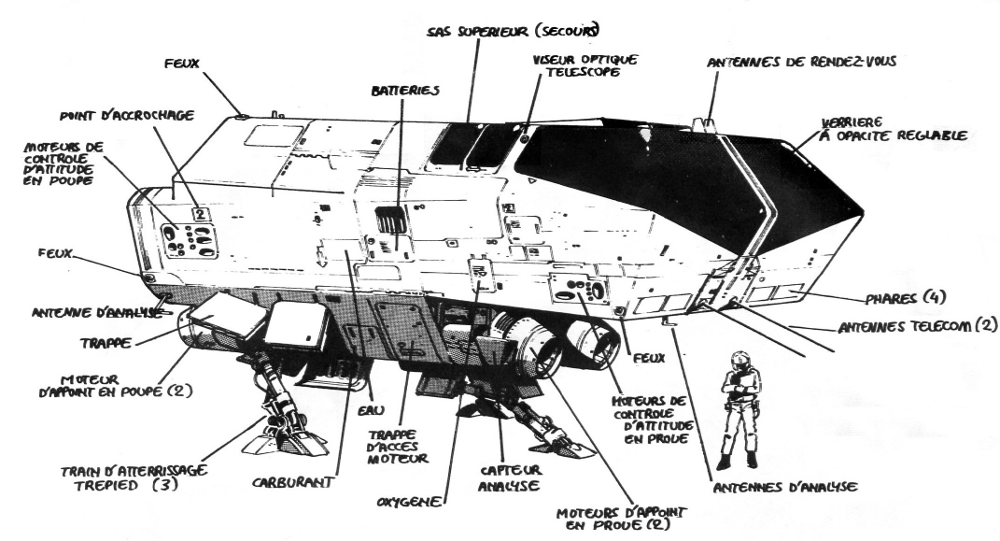
Tech level 4 shuttle.
There are 6 recognized technology levels across the Empire. The region it spans is so vast that it has many worlds for each tech level. The Empire itself (and its capital world) is considered tech level 6, the highest possible. Below is a brief description of each tech levels as well as examples of what one might expect to find to use for melee weapons, ranged weapons, transportation, communication, armor and computers (my favourite bit).
Tech Level 1: Stone Age
The most primitive cultures, tools are barely modified versions of what can be found naturally and myths and superstitions still rule society.
Melee Weapon: A stick
Ranged Weapon: A rock
Transportation: A pack animal
Communication: A torch
Armor: Animal furs/leathers
Computers: Your fingers
Tech Level 2: Pre-Industrial Age
Roughly the equivalent of the ancient world to the medieval era.
Melee Weapon: A sword
Ranged Weapon: A bow
Transportation: Horse, chariot, sail
Communication: A mirror, oil lamp, writing
Armor: Metal armor
Computers: Abacus
Tech Level 3: Industrial Era
About from the Renaissance to WWII in our-world terms.
Melee Weapon: Sword, knife, bayonet
Ranged Weapon: Pistol, Rifle
Transportation: Cars, boats, trains, planes
Communication: Radio, Phone
Armor: Bullet proof vest
Computers: Pocket calculator
Tech Level 4: Interplanetary Travel Age
This is from roughly now (well, 1987 I suppose) to the near future. Travel among the solar system is feasible and common place.
Melee Weapon: Stun Gun
Ranged Weapon: Laser Rifle
Transportation: Glider (below), space shuttles, jets
Communication: Solar-system ranged transmitter
Armor: Armored exo-suit
Computers: “This computer is vehicle based or in a large room and is much too big and heavy to carry around by one person, weighing 30kg or more”

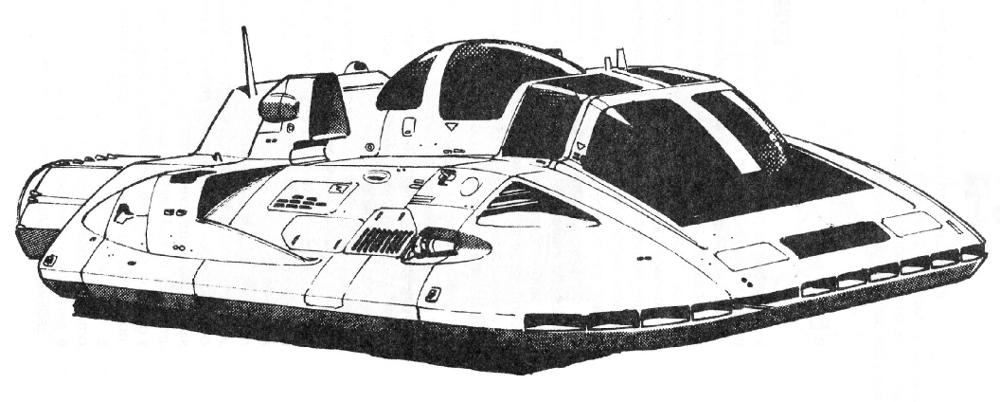
Glider
Tech Level 5: Interstellar Travel Era
Travelling to other solar systems is common place as is colonizing worlds.
Melee Weapon: Stunner
Ranged Weapon: Paralyzer (the first gun picture in post 1)
Transportation: Bubble
Communication: Interstellar communication
Armor: Antilaser suit
Computers: “This tech level’s computer is much more powerful than the one from tech level 4. It fits in a suitcase or similar sized container and can be plugged-in anywhere. It only weighs 5kg”

Tech Level 6: Intergalactic Travel Era
Travelling across the known galaxy is common place.
Melee Weapon: “Karatapoigne” which roughly translates to “Karate fist”. It’s a bracelet that creates shockwaves in the target’s body when you hit.
Ranged Weapon: Antigrav gun (creates different gravities within the target’s body which is… messy).
Transportation: Antigrav Bubble (below)
Communication: Intergalactic communication
Armor: Force fields
Computers: As good as a tech level 5 computer but the size of a pack of cigarettes.
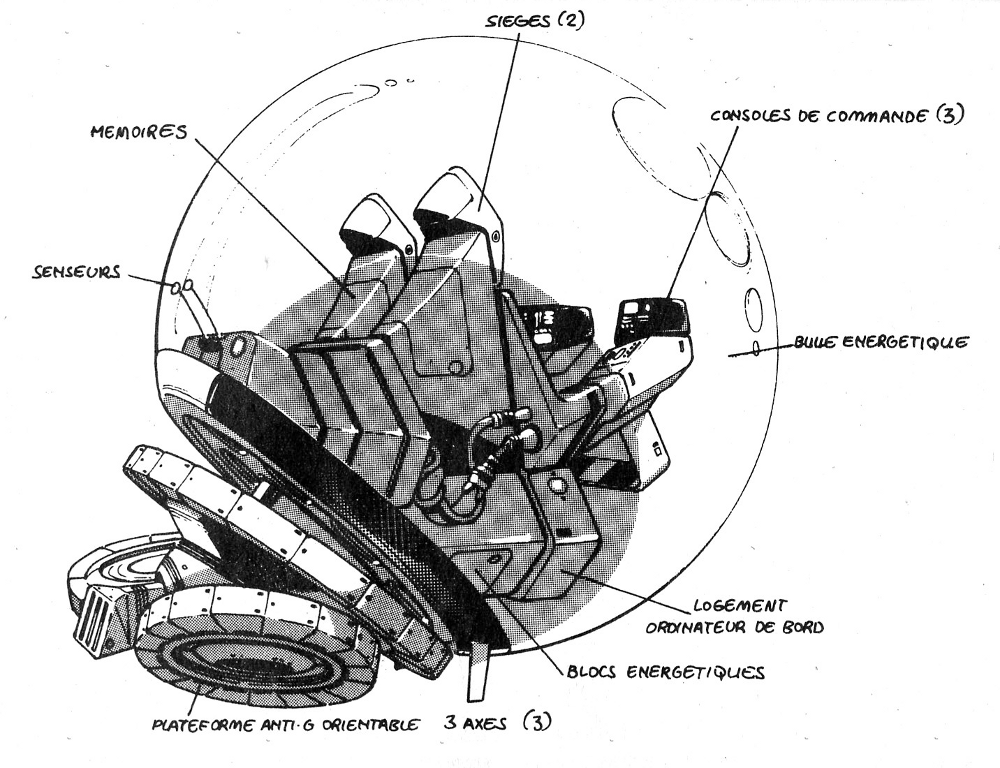
Antigrav bubble
next time: Generating Worlds and space travel
Strange New Worlds
Original SA post
Strange New Worlds
But first we have to get there
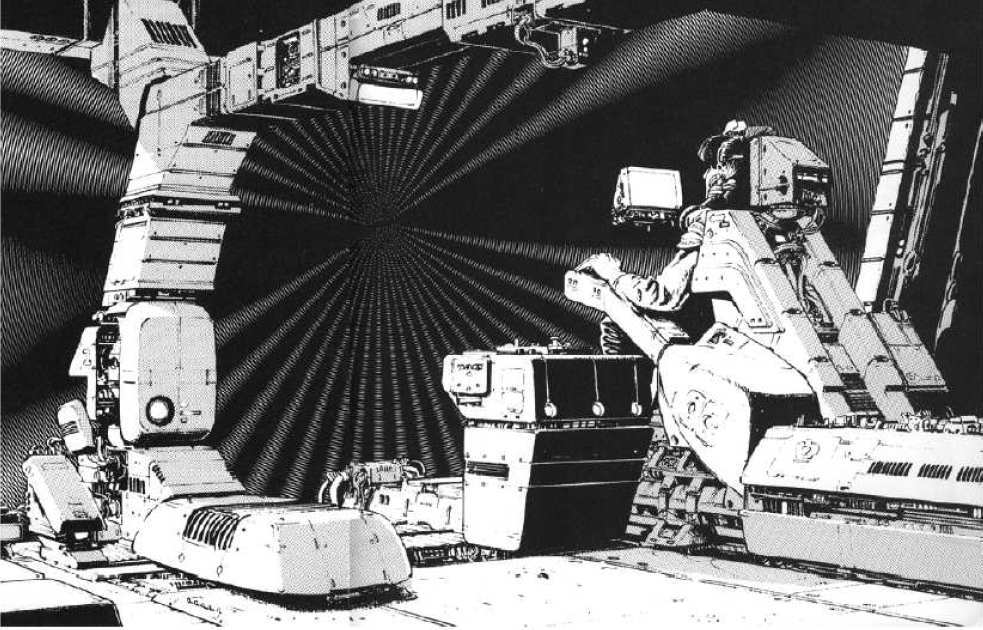
A Navyborg during FTL travel
Space travel in Empire Galactique is either done within the confines of a solar system – using a slower than light ship – or interstellar – with FTL capable ships. FTL ships usually move from space-port to space-port (usually both tech level 6). These space-ports are located at the extreme edge of solar systems. To get to your final destination within the solar system, you would take a shuttle from the port to whatever planet you want to go. A typical interstellar journey takes from a few days to a week and the travel portion at sub-FTL speeds will take a week or more. Passengers often end up spending more time in shuttles to and from space ports than on intergalactic transit.
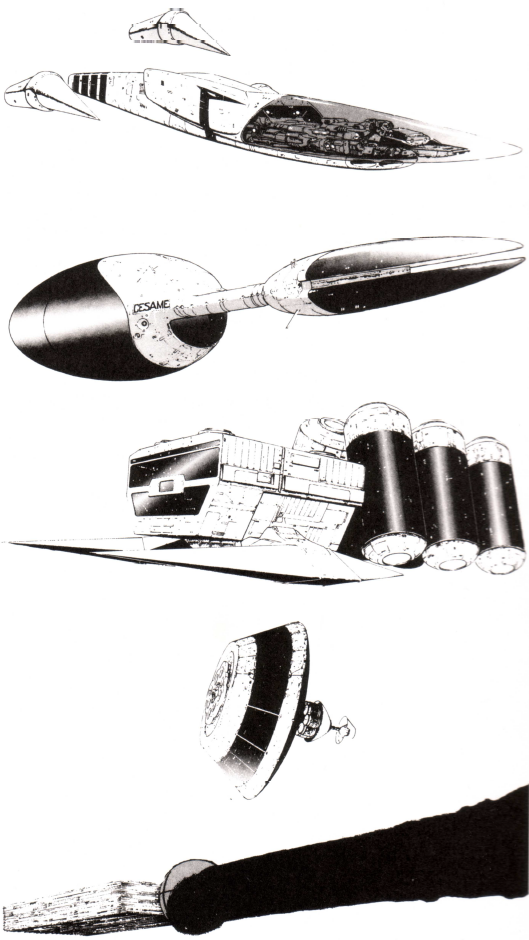
Various spaceships. From top to bottom: A fighter, a sub-light transport, a cargo ship, a luxury liner and an interstellar spaceship with black-hole drive (nothing ever goes wrong when using a black hole as your FTL drive)
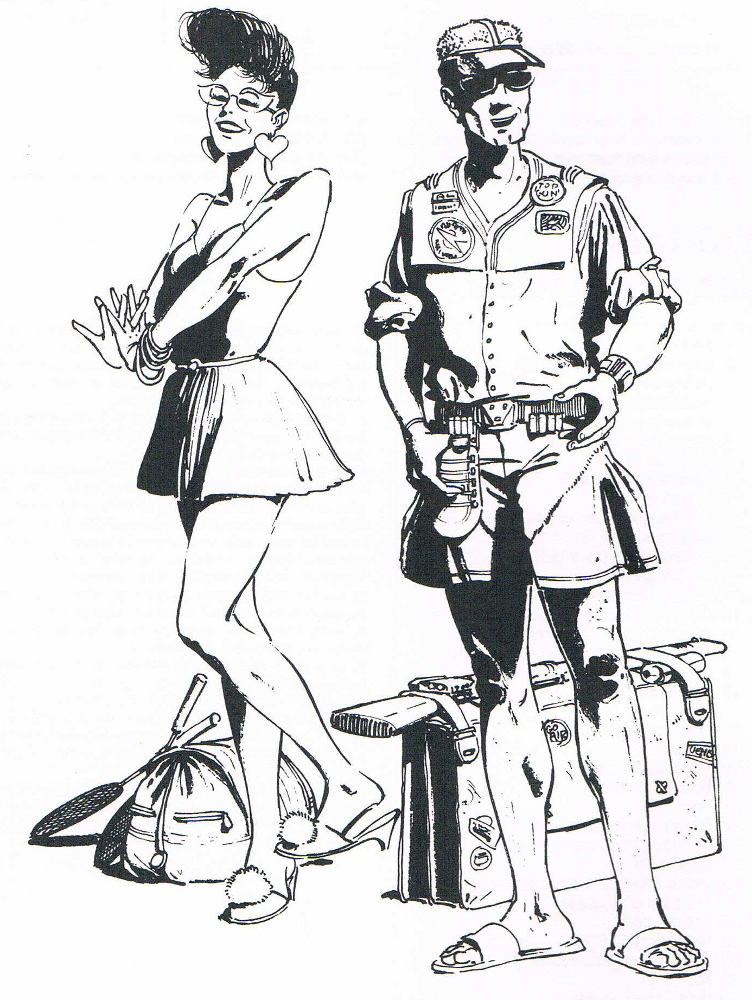
Space-Tourists
Generating Worlds
To create a new world, its fauna and flora, you roll on a bunch of tables (surprise, surprise). First you decide around where the system you are creating will be in relation to the galactic core (no map is provided) and then you go about the process of rolling d6s a whole bunch.
1. The Star
1d6. 1-3 = there’s a Sun, 4-6 it’s a starless system.
2. Planets
1d6. 1-3 there are planets (3d6 worth) 4-6 no planets.
3. The “Main” Planet’s Size
Here we’re focusing only on the one planet that might harbor indigenous life. Roll 2d6-2 x 2000km to get the diameter.
4. Gravity
Divide diameter d6 result by 6 to get gravity in Earth G’s
5. Ocean Area
2d6-2 x 10%. A result of 0 means it’s a desert planet with no water and 100% gets you an ocean world.
6. Atmosphere
Multiply the d6 result of Land Area by d6 result of Diameter and look up the results on a table. For example, 0 means a vacuum while 100 means a toxic/corrosive atmosphere.
7. Life
If the GM decides he wants the planet to have life forms, he rolls 1d6. 1-4 means there is animal life, 5-6 means intelligent life.
quote:
Let’s make a star system.
The Star: We roll 1, there’s a star
The Planets: 2. There are planets. 3d6 gets us 12 planets.
Main Planet size: 2d6x2000km. 11 gets us 22000km diameter.
Gravity: 11/6 = 1.8G
Land Area: 2d6-2. 4 gets us 40% Oceans.
Atmosphere: 4x11 on a table gets us a normal atmosphere. No suit needed.
Life: We’ll say there is. 5 on a d6 means it’s intelligent.
Generating Life Forms
Once you know if the planet will have life on it, you then get to roll a bunch more depending if it’s an animal or intelligent life form.
Animal Life
What does it eat? 1d6. 1=Omnivorous, 2-3=carnivorous 4+= herbivore (remember the number you got on the d6)
Where does it live? 1d6 (+1 if >70% oceans and +2 if 100%). 1-2 = Terrestrial, 3-4 = Marine, 5-6 = Avian
How strong is it? 1d6 + whatever you got on what does it eat. This is the STR stat of the animal.
Natural weapons GM fiat
Armor whatever you got on what does it eat x 2 = armor rating.
Size, weight 1d6 + results of what does it eat cross referenced on a table. Ex. A total of 10 means it’s 10-20m tall and weighs 3 tons. This means that herbivores are all at least 1m in size according to this way of calculating things
How does it look? 2d6 looked up on a table. Ex. A result of 3 means it’s a plant-life.
How does it react? 2d6 looked up on a table. Ex. A result of 3 means it will only attack when provoked.

quote:
Lets create a life form for our planet.
3 on “what does it eat” gets us a carnivorous animal.
4 on “where does it live” means it’s a marine life form.
5 on “how strong is it” gets us a total of 8 STR
We’ll say it has teeth for weapons
3x2 gets us an armor rating of 6
4 on size means it will be 1.5-2m long and weighs 60-100kg
8 on “how it looks” means it is humanoid in shape (merfolks???)
And 7 on reaction gets us a creature that it will flee at the first sign of intruders.
So there you have it. A human sized, sea dwelling, humanoid shaped life form that eats meat and is non-confrontational.
Intelligent Life
You would generate the stats of any ETs with the usual method but we have to find out a few things first.
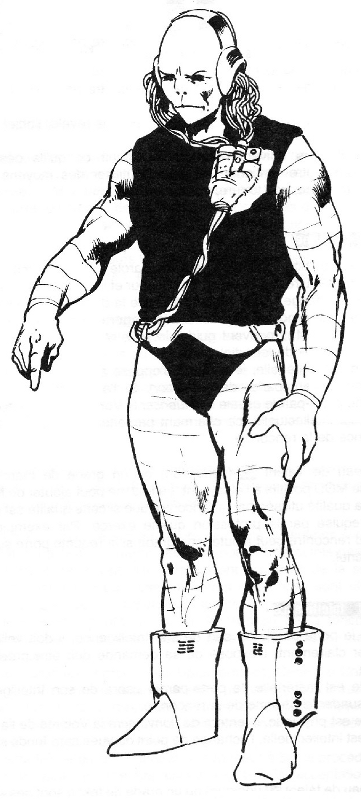
An Alien
Tech Level Roll 1d6 Ex. 2 means it’s tech level 2 (Pre-Industrial)
Size, weight 1d6 + results of what does it eat cross referenced on a table. Ex. A total of 10 means it’s 10-20m tall and weighs 3 tons.
How does it look? 2d6 looked up on a table. Ex. A result of 3 means it’s a plant-life.
Population d6 Tech Level result + Size d6 result. Add 10 zeroes to the total to get the population of the planet.
Civilization d6 + tech level. Look up the results of a table. Ex. 7 gets you a merchant society.
Nature Their comportment. d6 + tech level looked up on a table. Ex. 7 gets you Neutral.
Politics d6 + tech level looked up on a table. Ex. 7 gets you a democracy.
quote:
Lets create an alien.
For Tech Level we roll a 4. Meaning Interplanetary level. They may have colonized other worlds of their solar system.
(assuming they are omnivorous) For size we roll a 6. They are 2m tall and weigh 100kg or so.
On looks we got a 10. This is a mineral/geometric looking species
Population we roll a 3 and add tech level 4 for a total of 7 or 70,000,000,000 population
Civilization we roll a 1 and add tech level 4 for a total of 5 or Warrior culture
Nature we roll a 6 and add tech level 4 for a total of 10 or Hostile
Politics we roll a 6 again and add tech level 4 for a total of 10 or Theocracy.
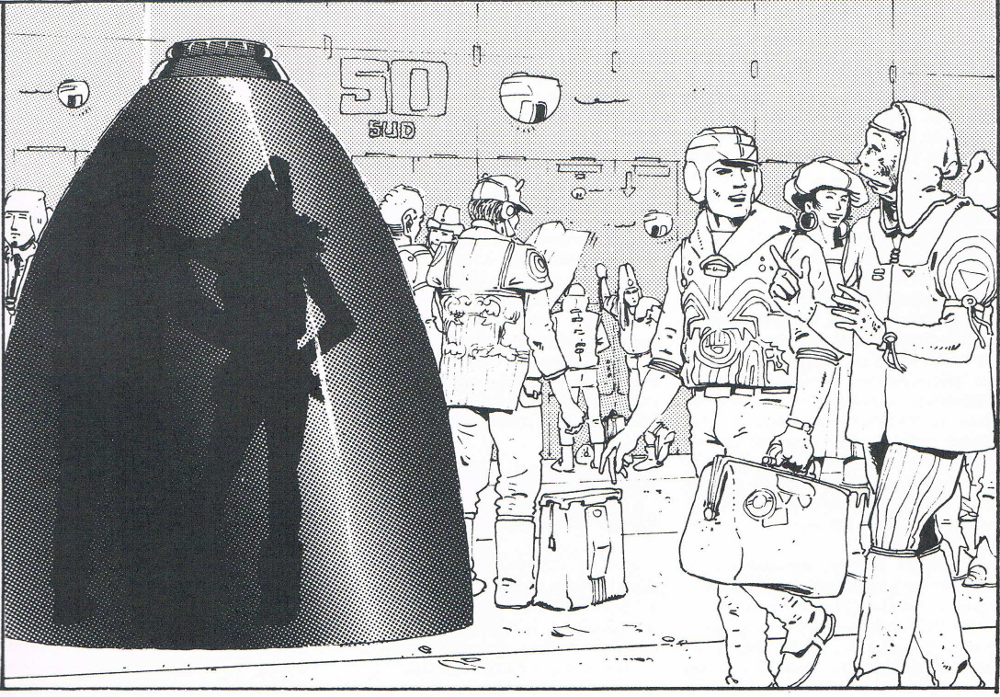
A cone of silence in action
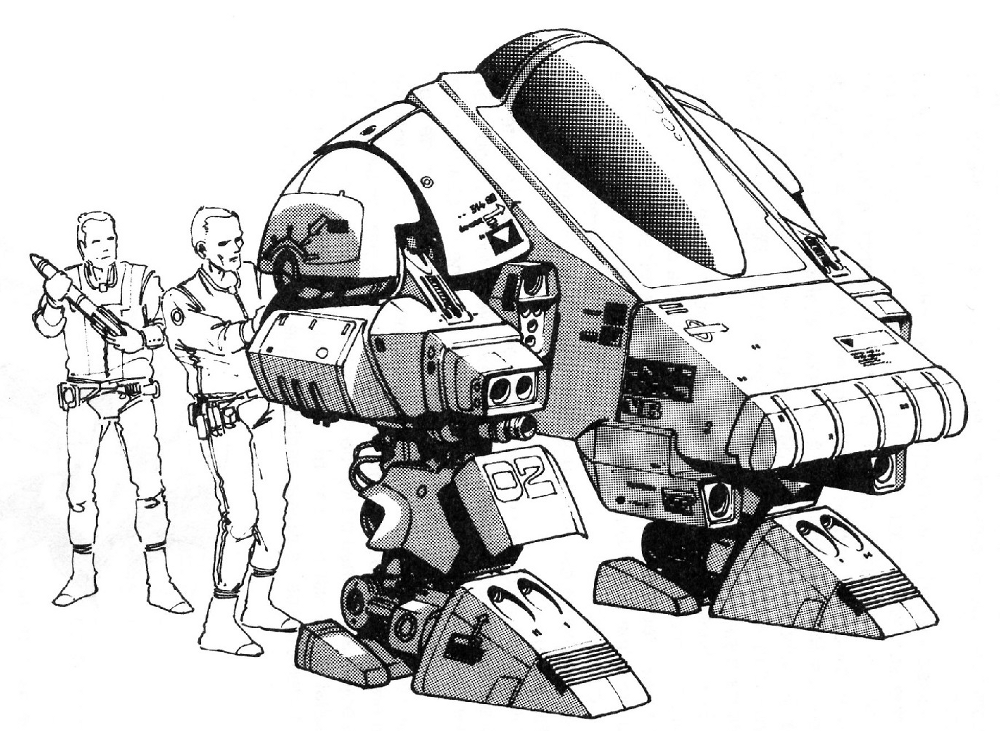
Tech Level 4 Mech
And this is it for Empire Galactique.